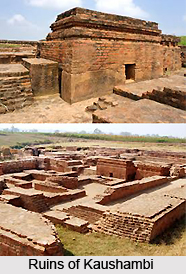 History of Kaushambi District states that this district was carved out from Allahabad District on 4th of April, 1997. According to historical accounts, this district of Uttar Pradesh has a very glorious past. In ancient India, hundreds of years before Christ, Kaushambi was the capital of Chedi-Vatsa Janapada, one of the prominent janapadas into which Indo-Aryan people were divided. As some of these janapadas figure prominently in the Brahmanas and Upanishad, it is not unlikely that the antiquity of Kaushambi goes back to the period of the Brahmanas. Shatapatha Brahamana, Hindu Scripture mentions a person called Proti Kaushambeya, a native of Kaushambi. This ancient antiquity of the city is confirmed by Mahabharata and Ramayana, the former ascribing its foundation to Kusamba, son of Kasu.
History of Kaushambi District states that this district was carved out from Allahabad District on 4th of April, 1997. According to historical accounts, this district of Uttar Pradesh has a very glorious past. In ancient India, hundreds of years before Christ, Kaushambi was the capital of Chedi-Vatsa Janapada, one of the prominent janapadas into which Indo-Aryan people were divided. As some of these janapadas figure prominently in the Brahmanas and Upanishad, it is not unlikely that the antiquity of Kaushambi goes back to the period of the Brahmanas. Shatapatha Brahamana, Hindu Scripture mentions a person called Proti Kaushambeya, a native of Kaushambi. This ancient antiquity of the city is confirmed by Mahabharata and Ramayana, the former ascribing its foundation to Kusamba, son of Kasu.
Further, according to the history of Kaushambi District, Kaushambi was the hermitage of the sage Kosamba, after whom it came to be known by that name. According to Indian Puranas, Nicaksu, the sixth in line from Parikshit, transferred his capital from Hastinapur to Kaushambi, as Hastinapur was ravaged by flood, invasion of locusts and upheavals in the Kuru family itself. Evidently, according to the legend, the city of Kaushambi was important enough to be selected as the new capital of the scion of the Pandavas. The legend thus corroborates the antiquity of the city as recorded in the Brahmanas, Mahabharata and Ramayana. There are several legends associated with the origin of the name of Kaushambi District. One legend suggests that Kausambi was so named because in course of its foundation, a large number of Kusamba trees were uprooted.
History also suggests that during Buddha`s time Kaushambi was one of the six most important and prosperous towns of India. It was the centre of ancient Indian communications as the principal routes from north to south and east to west met at the city. It was a terminus of river traffic and an important emporium of Madhyadesa. The city retained its importance at least up to sixth century AD, as it was visited by the Chinese pilgrims Fa-Hien and Yuan-Chwang. The ruins of the well-known site of Kaushambi are situated on the left blank of the Yamuna River at a distance of around 51 kms from Allahabad in a south-westerly direction. The remains of the ancient city give the impression of an imposing hillock reveals itself as a chain of rolling mounds, standing high above the surrounding plains, girdled on the south by the Yamuna. With the passage of time, the habitation level inside the city increased.



















